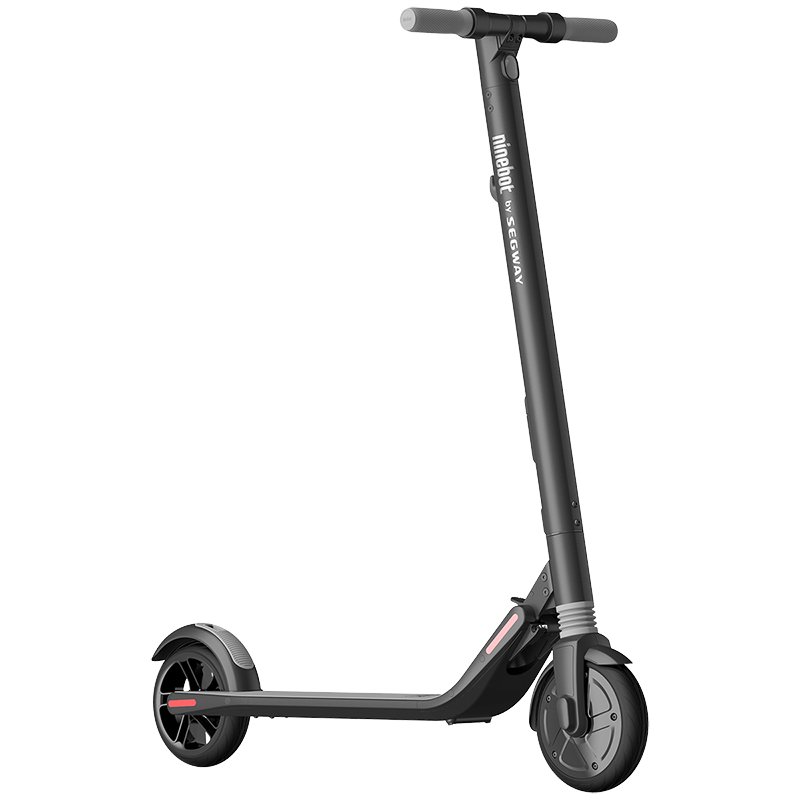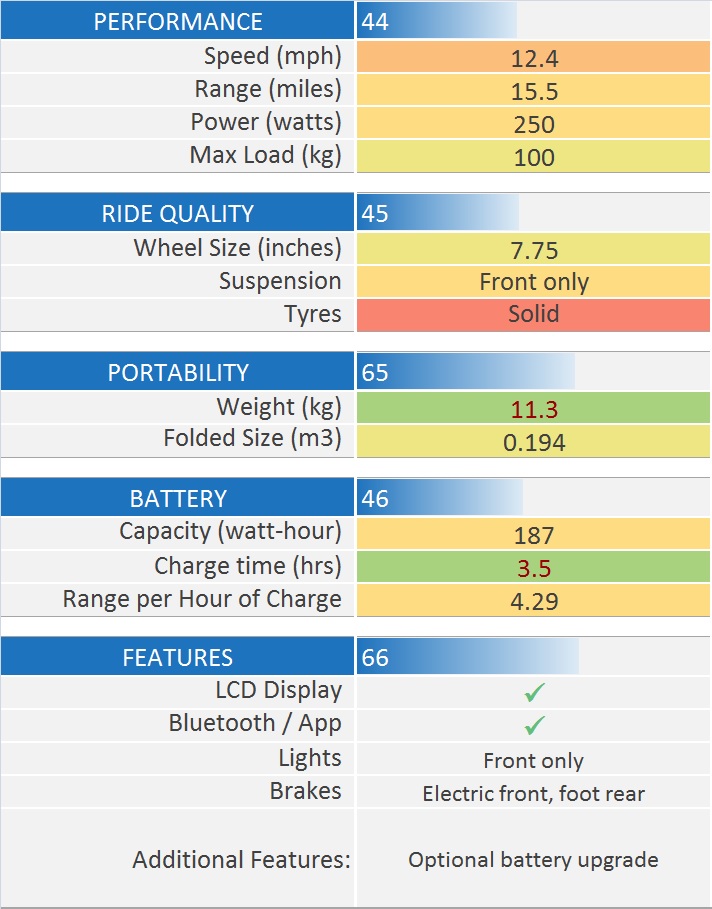Review Summary
The ES1 is Ninebot’s entry level scooter with modest speed and a respectable range. The ability to upgrade performance later with an additional battery (increasing speed and range), makes it a good proposition for the first time buyer.
Speed: 12.5 mph Range: 15.5 miles Weight: 11.3 kg Power: 250 Watt

Scooter Specification Score
Note: All scores are derived directly from scooter specifications using consistent formula. This enables objective comparisons between products.
PROS
- Attractive design from a reputable brand
- Ability to upgrade performance later (by purchasing additional battery) is useful option
- Solid tyres will appeal to some, as a way to avoid punctures
- Easy foot enabled folding mechanism
- Light weight
CONS
- Solid tyres mean a hard ride, despite front shock absorber
- Low top speed (without battery upgrade)
- No rear light
- Battery upgrade is not cheap
Who SHOULD buy? First time buyer not interested in speed but values the flexibility for a later upgrade. Good if you want to guarantee the avoiding punctures as the ES1 has solid tyres.
Who should NOT buy? I you are looking for a higher top speed or better ride comfort then look elsewhere.
Scooter Specification


Note: Fixed color coding rules are applied consistently across all products to ensure objective assessment of specifications.
Product Overview
For those who are not familiar to Ninebo-Segway, they can be considered a close cousin of the Xiaomi (the huge Chinese mobile phone manufacturer and maker of the well know M365 scooter). Xiaomi is an investor in Ninebot-Segway and the two companies collaborate in the manufacture of electric scooters, but products use different branding. Segway (a familiar brand Europe and North America) was acquired by Ninebot, making them one of the world’s biggest electric scooter manufacturers. This scale and brand recognition brings buyers a certain amount of reassurance. The ES1 has been on the market since 2017 and remains popular as an entry level scooter and it has really stood the test of time.
Design
The ES1 offers a sleek design which is arguably more modern than its famous cousin the M365 – this is high praise . The fundamentals of the ES1 design (which received a iF design award) is mirrored throughout all the scooters in the ES range. The design contains the battery in the front stem (rather than under the base plate, which is the more common battery location for electric scooters). The advantage of this is to give a sleeker deck and slightly more ground clearance (useful for going over bumps or off small curbs), although it does slightly compromise stability by placing weight higher up in the scooter. The design also incorporates a good folding mechanism and compaction when folded.
The presence of solid tyres means that one of the issue of getting a puncture (a big issue with some electric scooters as they can be hard to fix) is taken away. Many choose from the Ninebot ‘ES range’ of scooters for this very reason, but as mentioned already, there is a price to pay in ride comfort.
Another feature worth mentioning is that the ES1 can be used as a normal kick scooter when switched off (as there is no drag from the motor). This may appeal in scenarios where the scooter runs out of battery or if the rider simply chooses to propel themselves without using the motor for some of their journey to get some exercise.
Performance
Speed: 12.4 mph top speed puts it among the slowest of the adult electric scooters. But this is still more than four times walking pace and for those wishing to move around more quickly but not caring for high speed this is certainly adequate. And if you feel it’s not enough, there is always an option to upgrade to the more standard 15.5 mph top speed.
Range: Its range of 15.5 miles falls to more like 10 in real world conditions depending upon your weight, driving style. This is important to bare in mind if any round trip is going to be further than this.
Power: 250 W motor is perfectly adequate but the ES1 has gentle acceleration and can only tackle shallow inclines.
Max Load: 100 kg max load will be more than adequate for most users and scenarios. This is in line with the majority of electric scooters
Ride Quality
Wheels: Whilst the scooter feels solid and reassuringly well put together, the solid tyres deliver a hard ride, despite the front shock absorber which feels almost ineffective. Even for a slower scooter like the ES1 the ride is harsh on rough surfaces. This may be one of the biggest trade-offs of this scooter, which compared to alternatives with pneumatic tyres, delivers a relatively bumpy ride.
Portability
The compact folding design and lightweight body of the ES1 will be a strong selling point for some. At just over 11 kg it is lighter than the vast majority of electric scooters making it easy for taking on public transport or easy lifting into car boots or up stairs. It also has a very neat design allowing it to be dragged on one of its wheels whilst folded which may come in useful in some scenarios. However, if light and compact is a priority there are several alternative options that are smaller, lighter and have greater performance.
Battery
Capacity: A modest capacity of 187 Wh helps keep the overall cost of this scooter down whilst enabling a respectable range.
Charging: It takes a total of 3.5 hours to fully charge which is respectable. This equates to addin about 4.29 miles of range for every hour of charge which is about average.
Features
Lights: The front headlight is adequate but not particularly bright. Only reflector on the back meaning the rider will need to attach a light to themselves or their helmet for night time riding.
Display: Display indicates speed, battery power and your driving mode. The battery level display can be inaccurate while riding but then seems to adjust to accurate when the scooter is stopped. Cruise control works by holding throttle at a specific speed for a period of time after which the scooter will retain this speed when the throttle is released.
Bluetooth: Enables you to lock scooter, and control various settings.
Brakes: The scooter mainly relies on electronic regenerative brakes activated by a thumb lever on the left which is very similar to the throttle on the right of the handlebars. They take some getting used to but otherwise perform well enough. Putting too much pressure on the electronic brake can feel unstable which is particularly noticeable when first riding but becomes soon becomes intuitive. There is an additional brake on the rear which involves putting your foot on the rear fender to press against the back wheel. Regular kick-scooter riders may be familiar with this type of braking system but it generally it is not well suited to faster and heavier electric scooters and is often seen as a fallback option.
Conclusion
Unless you want to enforce speed restrictions (for example, if this is for a child or young teen) , it makes more sense to go straight to the ES2, you can always restrict the speed on the ES2 to start with by driving in slower modes)